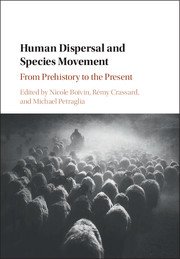Book contents
- Frontmatter
- Contents
- List of text boxes
- List of figures
- List of tables
- List of contributors
- Preface
- I Introduction
- II Origins: Species Movements in the Pleistocene
- 2 Carnivore guilds and the impact of hominin dispersals
- 3 Pleistocene hominin dispersals, naïve faunas and social networks
- 4 Hominins on the move: An assessment of anthropogenic shaping of environments in the Palaeolithic
- 5 Reconceptualising the palaeozoogeography of the Sahara and the dispersal of early modern humans
- III Across the water: Species movements by Coast and Sea
- IV Complexity: Species Movements in the Holocene
- V Invasion: The Movement of Invasive and Disease Species
- Index
- Plate section
- References
3 - Pleistocene hominin dispersals, naïve faunas and social networks
from II - Origins: Species Movements in the Pleistocene
Published online by Cambridge University Press: 04 May 2017
- Frontmatter
- Contents
- List of text boxes
- List of figures
- List of tables
- List of contributors
- Preface
- I Introduction
- II Origins: Species Movements in the Pleistocene
- 2 Carnivore guilds and the impact of hominin dispersals
- 3 Pleistocene hominin dispersals, naïve faunas and social networks
- 4 Hominins on the move: An assessment of anthropogenic shaping of environments in the Palaeolithic
- 5 Reconceptualising the palaeozoogeography of the Sahara and the dispersal of early modern humans
- III Across the water: Species movements by Coast and Sea
- IV Complexity: Species Movements in the Holocene
- V Invasion: The Movement of Invasive and Disease Species
- Index
- Plate section
- References
Summary
Abstract
Biogeographic studies of hominin dispersals address a variety of spatial and temporal scales. These studies are mostly concerned with establishing when dispersals occurred, and which types of environments were preferred by hominins. In this chapter, I argue that studies of dispersals need to consider the likely responses of prey species to incoming hominin groups, and the cognitive, social and technical skills of the hominins involved. When the earliest hominins in Eurasia (and later, the earliest humans in the Americas and Australia) dispersed into new areas, they encountered a fauna that would have been initially naïve about the threat posed by a new predator. This naivety would have made predation easier, and facilitated further expansion by hominins, and later, Homo sapiens. The second point argued in this chapter is that because hominins are the only animals that are known to have changed their behaviour substantially in the course of their evolution, it is inadequate to treat them as biogeographically equivalent to less cognitively advanced species like rabbits or rhinos. This is particularly the case when discussing the expansion of H. sapiens into new areas such as Siberia, Japan, the Philippines, Australasia and ultimately the Americas. In these examples, attention needs to be directed towards establishing the type of networks that human groups established for obtaining and sharing information and resources.
Keywords: Out of Africa 1, Out of Africa 2, naïve faunas, vigilant faunas, social networks
INTRODUCTION
Dispersals underpin most current narratives of human evolution. They are fundamental to the story of how our ancestors originated in Africa, developed into a bipedal tool-making carnivorous primate, moved into Asia and Europe after 2 Ma, and eventually, by the end of the Pleistocene ca. 10,000 years ago (10 ka), colonised every continent except for Antarctica (see Boivin, Introduction to this volume). The record for human evolution in Eurasia is usually portrayed as the outcome of two major dispersal events: the first, often referred to as Out of Africa 1, documents the dispersal after 2.0 Ma of Homo erectus – the earliest documented inhabitant of Asia – as far east as northern China and Java, Indonesia, and as far west as Spain by 1.4 Ma; the second, commonly known as Out of Africa 2, concerns the expansion of our own species, Homo sapiens, from Africa across Eurasia after ca.
- Type
- Chapter
- Information
- Human Dispersal and Species MovementFrom Prehistory to the Present, pp. 62 - 89Publisher: Cambridge University PressPrint publication year: 2017
References
- 2
- Cited by



